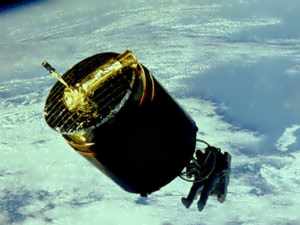|
Repair & Maintenance Facility

Function:
To provide a workshop
To store spare parts
To store tools and equipment
To carry out repairs
To plan and execute maintenance procedures
To store space suits
To provide facilites for donning space suits

 In the future this will be one of the most important aspects of Space Station activity. Bringing back and repairing damaged, worn-out or just old satellites will be a major business. In the future this will be one of the most important aspects of Space Station activity. Bringing back and repairing damaged, worn-out or just old satellites will be a major business.
All spacecraft are expensive to build and launch, and any that fail before their time are an enormous loss. Several satellites and other spacecraft have been successfully repaired or up-graded in space. SolarMax, Westar 6 (left), Palapa B2 and the Hubble Space Telescope are examples.
© Image: NASA

This facility is the Space Station workshop and store. It also serves as a place where astronauts can put on their space suits for EVA.
Think about the problems of a workshop in microgravity. Here are just three major problems to overcome.
- How would you store tools?
- How would you collect particles from cutting operations such as sawing?
- How easy would electronic assembly and repair be?

Micrometeoroids - An External Threat to the Space Station
The space station will be in orbit above the Earth, and also above the protective blanket of our atmosphere. As well as providing us with something to breathe, the atmosphere also protects us from the hostile conditions of space. The space station will face problems of solar heating, radiation and micrometeoroid impacts.
All the individual grains of rock and dust in space are called "meteoroids" while they are in space, if they burn up in the atmosphere they become "meteors", or "shooting stars", and if they survive to hit the Earth, they are called "meteorites". Above the atmosphere, the space station will be unprotected from these. Micrometeoroids may be natural, or man-made - consisting of particles of paint or other debris from satellites, launchers etc. Even microscopic particles may cause a lot of damage, because they are moving at very high speed. A Shuttle Orbiter windscreen, which is several centimetres thick, was cracked be a tiny paint fragment during one mission.
Typical impact speeds can be anything up to 50,000 kph (34,000 mph)
The energy a particle has can be calulated from the Kinetic Energy equation:
Energy = 1/2 mv2
where m is the mass of the particle and v is the velocity (speed in a straight line). Now the speed of particle has more effect, energywise, than the mass. If for instance we double the mass, all we do is double the energy. But if we double the speed, the energy the particle has is four times as much. And when it hits something it is four times as devastating. That's true for a car on the street or a fleck of paint in space.
When a particle hits something, all its speed is lost and there is a massive energy release. This kinetic energy - energy of movement - is released into whatever the particle hits and is turned into other forms of energy. Impacts usually produce heat and sound, but they may also produce light or even electricity under some circumstances. Also, even smaller particles than the impactor are cracked off and fly away at high speed, using some of the released energy.
Now you can calculate how much energy a fleck of paint can release during an impact.
The paint fleck has a mass of 0.001 gram, and it is travelling at 25,000 kph when it hits the windscreen of a Shuttle and releases all its energy. How much energy is released?
Now that is very small particle of paint. You could fit several on your finger nail.
Solution:
We need to turn everything into the same units, and as the SI system is the world standard we shall use that.
Turn the speed into metres per second.
There are 1000 metres in a kilometre, and 3600 seconds in an hour (60x 60)so
(25000 x 1000)/(60 x 60) = 6944 metres per second
And turn the grams into kilograms:
0.001 grams is 1/1000 gram and 1/1,000,000 of a kilogram.
So now we work out the energy:
Energy = (6944 x 6944)/1,000,000
That is 48 Joules which is enough to heat a one bar electric fire for 3 minutes.
On hitting our windscreen all that energy is released in a fraction of a second. No wonder it cracked!

Task:
Now see what the energy release would be from a micrometeorite weighing just one gram - the size of your fingernail - travelling at 50,000 kph. Work it out in terms of how long the electric fire would run.
The answer is in the power module.

For more information about forces, energy and things that move go to Newton's Motions.

Go to Space Station 2020 Specification
Return to title page
 |













